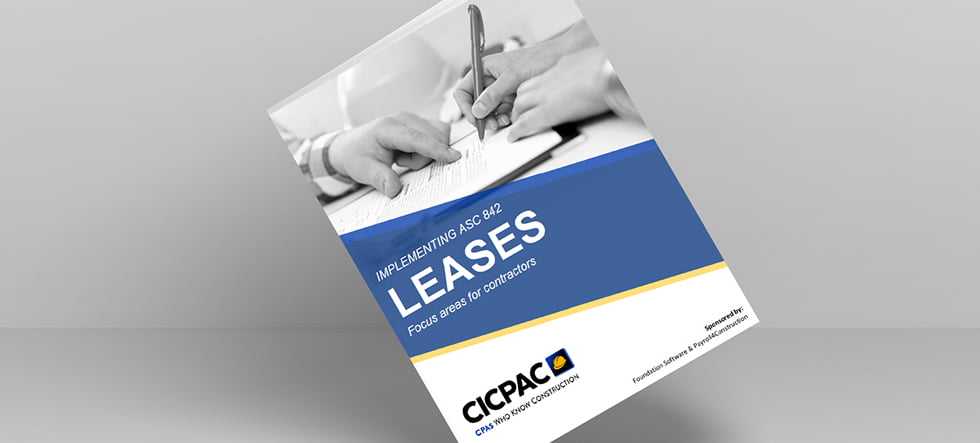
It is time for contractors to get serious about the FASB ASU 2016‐02 ASC 842 Leases, the new lease accounting standard issued by the Financial Accounting Standards Board (FASB). The contractor’s focus should be on the impact the lease standard will have on the company, specifically bank and surety considerations, and the specific attributes such as embedded leases, related party leases, consolidation (when there is a variable interest entity), and how to apply the standard to these situations.
“How does this affect my financial statements?”
The prior accounting standard (ASC 840) only required capital leases to be included on the balance sheet. ASC 842 keeps the same two-model lease classification but requires most off-balance-sheet leases, regardless of classification type, to be recorded on the balance sheet. Going forward there will be a long-term asset offset by a current liability and a long-term liability. This requirement is FASB aiming for better transparency into the financial positions of companies.
While both operating and finance leases will be recorded on the balance sheet, expense recognition is different. Operating leases will require lease expense to be recognized on a straight-line basis over the lease term. Finance leases will require the lessee to recognize interest expense and amortization expense. As a result, the lessee will usually recognize a greater expense earlier in the life of finance leases.
“All my leases are related party.”
Under the new lease standard, leases with related parties should be treated in the same manner as leases with unrelated parties. According to ASC 842-10-55-12, these leases “should be classified in accordance with the lease classification criteria applicable to all other leases on the basis of the legally enforceable terms and conditions of the lease.” These types of transactions are not always sufficiently documented, and terms and conditions may not be at arm’s length. As a result, it is imperative to consider all factors that may result in legally enforceable rights and obligations. It cannot be assumed that a lease would not need to be considered if the terms are not formally documented, because unwritten terms can create enforceable rights and obligations.
"Where do I start in preparing for the new lease standard?”
There are several steps you should take now to prepare for a successful transition to the new standard:
- The first step is to:
- Build an inventory of your leases
- Determine how to account for each lease
- Consider the benefits of practical expedients
- The next steps will involve discussing the impact to your company’s financial statement with your bankers, sureties, and other lenders.
Existing debt covenant calculations may need to be amended as a result of the implementation of the new lease standard. Awareness and education will be the construction financial professionals’ most powerful tool in guiding the contractor’s banker and surety in analyzing, understanding and adjusting to these changes.
Construction Industry CPAs and Consultants (CICPAC) recently released a whitepaper titled: ASC 842 – Implementing Leases – Focus areas for contractors. The white paper provides detailed insight to the key areas you should consider when implementing the new standard.
CICPAC is a national association of over 75 accounting firms who exemplify vast knowledge, respectable histories, and more than 900 high-quality financial and consulting professionals. Contact the CPAs Who Know Construction when looking for skilled resources to help your company. Visit www.cicpac.com.

